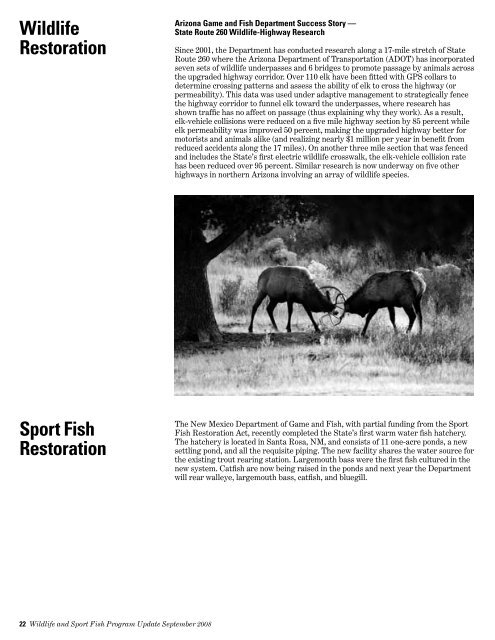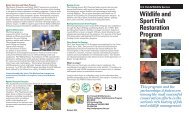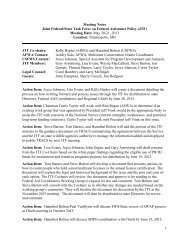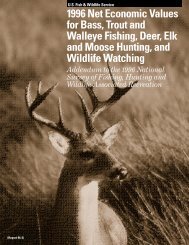Program Update - Wildlife and Sport Fish Restoration Program - U.S. ...
Program Update - Wildlife and Sport Fish Restoration Program - U.S. ...
Program Update - Wildlife and Sport Fish Restoration Program - U.S. ...
Create successful ePaper yourself
Turn your PDF publications into a flip-book with our unique Google optimized e-Paper software.
<strong>Wildlife</strong><br />
<strong>Restoration</strong><br />
Arizona Game <strong>and</strong> <strong>Fish</strong> Department Success Story ––<br />
State Route 260 <strong>Wildlife</strong>-Highway Research<br />
Since 2001, the Department has conducted research along a 17-mile stretch of State<br />
Route 260 where the Arizona Department of Transportation (ADOT) has incorporated<br />
seven sets of wildlife underpasses <strong>and</strong> 6 bridges to promote passage by animals across<br />
the upgraded highway corridor. Over 110 elk have been fitted with GPS collars to<br />
determine crossing patterns <strong>and</strong> assess the ability of elk to cross the highway (or<br />
permeability). This data was used under adaptive management to strategically fence<br />
the highway corridor to funnel elk toward the underpasses, where research has<br />
shown traffic has no affect on passage (thus explaining why they work). As a result,<br />
elk-vehicle collisions were reduced on a five mile highway section by 85 percent while<br />
elk permeability was improved 50 percent, making the upgraded highway better for<br />
motorists <strong>and</strong> animals alike (<strong>and</strong> realizing nearly $1 million per year in benefit from<br />
reduced accidents along the 17 miles). On another three mile section that was fenced<br />
<strong>and</strong> includes the State’s first electric wildlife crosswalk, the elk-vehicle collision rate<br />
has been reduced over 95 percent. Similar research is now underway on five other<br />
highways in northern Arizona involving an array of wildlife species.<br />
<strong>Sport</strong> <strong>Fish</strong><br />
<strong>Restoration</strong><br />
The New Mexico Department of Game <strong>and</strong> <strong>Fish</strong>, with partial funding from the <strong>Sport</strong><br />
<strong>Fish</strong> <strong>Restoration</strong> Act, recently completed the State’s first warm water fish hatchery.<br />
The hatchery is located in Santa Rosa, NM, <strong>and</strong> consists of 11 one-acre ponds, a new<br />
settling pond, <strong>and</strong> all the requisite piping. The new facility shares the water source for<br />
the existing trout rearing station. Largemouth bass were the first fish cultured in the<br />
new system. Catfish are now being raised in the ponds <strong>and</strong> next year the Department<br />
will rear walleye, largemouth bass, catfish, <strong>and</strong> bluegill.<br />
22 <strong>Wildlife</strong> <strong>and</strong> <strong>Sport</strong> <strong>Fish</strong> <strong>Program</strong> <strong>Update</strong> September 2008










